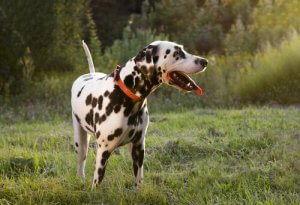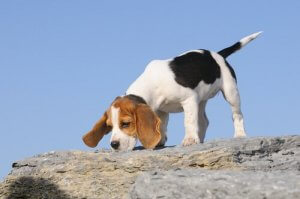Dog Tail Also Wags If Dogs Are Sad


Written and verified by the lawyer Francisco María García
We think dogs wag their tail only when they’re happy. However, it can also be a sign of sadness. The difference between grief and joy depends on the dog’s tail direction. If it’s on the right side, then it’s a signal of positive emotion. If it’s on the left side, then it’s a negative emotion.
Studies showed that dogs suffer an increased heart rate and anxiety when seeing another dog with their tail tilted slightly to the left. The explanation is due to negative sensations such as feeling in danger or perceiving a threat.
Nevertheless, when a dog tilted its tail to the right, the other dog remained relaxed. For this reason, the tail wagging is a sign of a type of communication. This is because of the asymmetric functioning of a dog’s brain. In this case, the tail would tip to the side of the active cerebral hemisphere at a given time.
For us, as human beings, it’s not easy to detect dog tail movements. However, for dogs it’s natural.
Tail movements

Almost all our pet’s tail movements say something either to us or to other animals. That’s why it’s important for dogs to have a tail. It’s good for socializing and to avoid problems with other dogs. As we can see, it’s the closest thing to human facial expressions.
But there’s more, the tail movements spread the smell of pheromones that our animals have in their anal glands. It’s another channel of dog communication.
What a wagging dog tail really means
- Circular movements. The dog is showing empathy, fun, and the desire to play.
- Fast tail movements from one side to the other. The dog feels agitation, happiness, and joy, but also impatience and nervousness. Contrary to what’s believed, in these cases the dog is torn between desire and fear. A desire to do something and fear of what happens if they do it.
- For example, if we put a plate of food in front of our dog, if the animal sees us approaching, instead of having a relaxed tail, they’ll wag it, showing happiness generated by the food and suspicion of the human being who could take the food away.
- Short and fast movements. In these cases, if the ears are bent back and the dog is showing its teeth, that means the dog is ready to attack.
- The tip of the tail lifts upwards. The dog is showing its authority. It’s the dominant dog and it’ll be difficult to change its mind.
- The tip of the tail is raised and curved. The dog is showing its confidence and self-control.

Dog tail positions
- If the tail is horizontal, it’ll usually indicate that there’s something of interest to the dog. Something caught its attention.
- If the tail is usually horizontal and tense with bristly hair, the dog is nervous about a possible confrontation. It’s better to get away from the dog.
- If the tail low and far from its hind legs. This is a sign that the dog is calm and relaxed.
- If the tail is low, close to its hind legs and with slight lateral movements, the dog is insecure. The dog is uneasy and doesn’t like what’s in front of it or around it.
- If the tail is between the legs, that’s usually because of fear. In other words, dogs get scared. It can also mean submission to the dominant member of the pack. This movement is very important and it’s a big loss if the tail is cut. That’s because no pheromones are spread when the tail is between the legs. It adds a sense of privacy.
We think dogs wag their tail only when they’re happy. However, it can also be a sign of sadness. The difference between grief and joy depends on the dog’s tail direction. If it’s on the right side, then it’s a signal of positive emotion. If it’s on the left side, then it’s a negative emotion.
Studies showed that dogs suffer an increased heart rate and anxiety when seeing another dog with their tail tilted slightly to the left. The explanation is due to negative sensations such as feeling in danger or perceiving a threat.
Nevertheless, when a dog tilted its tail to the right, the other dog remained relaxed. For this reason, the tail wagging is a sign of a type of communication. This is because of the asymmetric functioning of a dog’s brain. In this case, the tail would tip to the side of the active cerebral hemisphere at a given time.
For us, as human beings, it’s not easy to detect dog tail movements. However, for dogs it’s natural.
Tail movements

Almost all our pet’s tail movements say something either to us or to other animals. That’s why it’s important for dogs to have a tail. It’s good for socializing and to avoid problems with other dogs. As we can see, it’s the closest thing to human facial expressions.
But there’s more, the tail movements spread the smell of pheromones that our animals have in their anal glands. It’s another channel of dog communication.
What a wagging dog tail really means
- Circular movements. The dog is showing empathy, fun, and the desire to play.
- Fast tail movements from one side to the other. The dog feels agitation, happiness, and joy, but also impatience and nervousness. Contrary to what’s believed, in these cases the dog is torn between desire and fear. A desire to do something and fear of what happens if they do it.
- For example, if we put a plate of food in front of our dog, if the animal sees us approaching, instead of having a relaxed tail, they’ll wag it, showing happiness generated by the food and suspicion of the human being who could take the food away.
- Short and fast movements. In these cases, if the ears are bent back and the dog is showing its teeth, that means the dog is ready to attack.
- The tip of the tail lifts upwards. The dog is showing its authority. It’s the dominant dog and it’ll be difficult to change its mind.
- The tip of the tail is raised and curved. The dog is showing its confidence and self-control.

Dog tail positions
- If the tail is horizontal, it’ll usually indicate that there’s something of interest to the dog. Something caught its attention.
- If the tail is usually horizontal and tense with bristly hair, the dog is nervous about a possible confrontation. It’s better to get away from the dog.
- If the tail low and far from its hind legs. This is a sign that the dog is calm and relaxed.
- If the tail is low, close to its hind legs and with slight lateral movements, the dog is insecure. The dog is uneasy and doesn’t like what’s in front of it or around it.
- If the tail is between the legs, that’s usually because of fear. In other words, dogs get scared. It can also mean submission to the dominant member of the pack. This movement is very important and it’s a big loss if the tail is cut. That’s because no pheromones are spread when the tail is between the legs. It adds a sense of privacy.
This text is provided for informational purposes only and does not replace consultation with a professional. If in doubt, consult your specialist.








